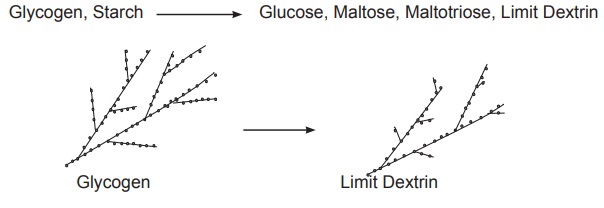Chapter: Biochemistry: Digestion
Carbohydrates in Digestion
Carbohydrates
The major carbohydrates present in our diet are
starch, glycogen, sucrose, lactose , maltose and very little concentrations of
fructose and pentose.
1. Digestion in mouth
Milk and other fluid items like juices escape
digestion in the mouth as they do not reside in the mouth for a longer time,
whereas, starch and glycogen containing solid foods are masticated with saliva
thoroughly. Saliva contains ptyalin, an a amylase, which attacks the a 1-4
linkages resulting in the formation of monosaccharide glucose, disaccharide
maltose and trisaccharide maltotriose. However, because of steric hindrance
caused by the branches, some of the interior a 1-4 linkages are inaccessible for
the enzyme. This results in the formation of a highly branched structure called
as limit dextrin.
The optimum pH for salivary amylase is pH 6.7.
Ptyalin needs chloride ions for their effective action.
Glycogen, Starch -------->
Glucose, Maltose, Maltotriose, Limit Dextrin

When food along with ptyalin reaches the
stomach, ptyalin is inactivated due to low pH. There are no enzymes to act upon
carbohydrates in the stomach. No change to polysaccharides occurs in the
stomach. Dietary sucrose may be hydrolyzed to equimolar quantities of glucose
and fructose by the HCl present.
2. Digestion in duodenum
When the food bolus reaches the duodenum, it is
mixed with the pancreatic juice, which contains α - amylase. Its action is
similar to that of the ptyalin, but it is more powerful because
·
It
can act upon raw starch.
·
It
can hydrolyze the interior linkages of the starch, which were inaccessible for
ptyalin.
The optimum pH of
pancreatic amylase ranges between 6.9 – 7.1 and it needs chloride ions for its
action
3. Digestion in small intestine
Five enzymes are present in small intestine to
hydrolyze the carbohydrates completely to monosaccharides.
a. Intestinal
amylase :It hydrolyses the
terminala1-4 linkages in polysaccharidesand oligosaccharides releasing free
glucose molecules.
b. Lactase
:It isb-galactosidase
that hydrolyses lactose molecule to equimolar amounts of glucose and galactose.
Its optimum pH is 5.4 – 6.0

c. Maltase : It is a glucosidase that acts ona1-4 linkages of maltose yieldingglucose molecules. Five different maltases have been identified in the intestinal epithelial cells. Its optimum pH ranges between 5.8 – 6.2.

d. Sucrase
: It hydrolyzes sucrose
to equimolar amounts of glucose and fructose byhydrolyzing b 1-2 linkages.

e. Isomaltase
: It hydrolyses
thea1-6 branch points of limit dextrin and liberatesmaltose and glucose.
There are no enzymes present in our digestive
system to hydrolyze b1,4 linkages in cellulose, so it cannot be digested.
4. Absorption of carbohydrates
Only monosaccharides can be absorbed by the
intestinal mucosa. A few disaccharides can be pinocytosed and hydrolyzed to
monosaccharides by disaccharidases. The absorption rate of the monosaccharides
is in the following order:
Galactose > Glucose > Fructose >
Mannose > Xylose > Arabinose
Mechanism of absorption
1. Simple
Diffusion: Initially, when
the concentration of glucose in the intestinallumen is high, by simple
diffusion it crosses the membrane.
2. Active
Transport: To speed up the
absorption process, active transportmechanisms are involved. Absorption of
glucose is a secondary active transport process, which involves ATP hydrolysis
indirectly.
The steps involved in the transport of glucose are :
·
One
molecule of Na+ and glucose binds to the transporter.
· Binding of sodium and glucose induces a conformational change in the transporter.

·
The
conformational change leads to the delivery of sodium and glucose molecules to
the intestinal cells.
·
Sodium
is pumped out of the cell resulting in the net absorption of glucose molecule
alone.
Step (iv) needs energy that is derived by ATP
hydrolysis.
5. Factors affecting rate of absorption
·
If
the intestinal mucosa is damaged, absorption is reduced.
·
Hormones
like thyroid hormone, adrenal cortex hormones and pituitary hormones enhance
the absorption of carbohydrates.
·
Insulin
has no effect in the absorption of glucose.
·
Pyrimidine
and pantothenic acid deficiencies diminish the absorption.
·
Inherited
enzyme deficiency states like lactose intolerance decreases the absorption.
Related Topics